 |
1. Most private exotic and
domestic animal owners donít have the thousands or millions of
dollars needed to construct a beautiful, fancy pool and waterfalls
seen at major zoos.
The round or long standard metal livestock water tanks with the
drain are some of the most used water containers, and are available
in many different sizes. Sometimes, an old bathtub can be used for
the same purpose.
The upside is that they are relatively cheap, easy to find, clean,
and are durable. The downside is that they are ugly and get too hot
in the summer. The animals are less likely to try to climb into them
in order to avoid touching the hot metal surface. |
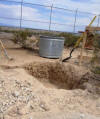 |
2. Living in the hot Nevada desert and not
wanting to waste water, we decided to make the tubs more
aesthetically pleasing, as well as practical. To insulate them to
keep the water cooler in summer, we bury them in the ground.
If you donít have sloping ground, you can build a mound. |
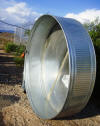 |

3. We worked with one old plastic bathtub and few metal tanks, round
and long ones. |
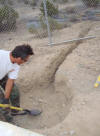 |

4. The hole is dug in the shape of the tub. The ditch for the drain
pipe continued to the outside of the cage, so the animals canít get
to it and chew on the drain valve. |
 |
5. The soil in the high desert is very dry and
rocky, so we used a sifter to get rid of the big rocks from the soil
excavated from the hole. The fine sifted soil (can be substituted
with sand) is then used to fill in the space around the tub in the
hole. When setting the tub in the ground, use the sifted soil to
level the tub. If the tub drain is on the side, angle the tub
slightly toward the drain. Since tub drains tend to be predrilled
about 1 inch from the bottom, this helps to more completely drain
the water from the tub. |
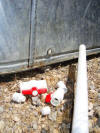 |
6. We used the plastic PVC pipe available in home
building stores.
The wider the pipe, the faster the pool will drain and the less
likely it will get clogged with the animal hair and other debris.
Depending on what size the existing tub drain hole is, you can get
different attachments, fittings and valves to drain the tub. |
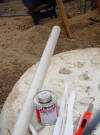 |
7. PVC pipe cement/glue was used to seal the pipe
and attachments. |
 |
 8. Once the pipe is tested for leakage, it is then buried under
the soil. The only thing left exposed is the valve to drain the tub.
8. Once the pipe is tested for leakage, it is then buried under
the soil. The only thing left exposed is the valve to drain the tub. |
 |
 9. Time to fill up the in ground tubs with water.
9. Time to fill up the in ground tubs with water. |
 |
10. The tubs passed the technical test and are
now tiger approved. However, leaving soil around the tub will
increase the rate at which the tub water would get muddy, thus
increasing the frequency at which the water needs to be changed.
Being sensitive to Nevada water issues, we decided to fix the
problem by pouring concrete around it and setting in the combination
of commercial stepping stones and local boulders. |
 |
11. We bought few bags of pre-mixed concrete mix. |
 |
12. The other tools used were a plastic mixing
tub, liquid cement color to make the concrete match the color of the
stepping stones, and various trowels and spatulas to spread the
concrete mix. |
 |
13. This metal round tub was on a slight hill and
we decided to increase the slope even more. |
 |
14. We arranged large native boulders in a half
circle around the elevated portion of the in ground metal tub and
filled it with smaller rocks and dirt. |
 |
15. Then we put wire rabbit fencing over it to
keep it all together. |
 |
16. Next we sprayed our rock structure with water
to prepare it for the pouring of concrete. |
 |
17. The Concrete mixed with cement color was
poured inside the boulder ĎstructureĒ and directly on the ground
around the rest of the tub. The stepping stones were set in the
colored concrete around the tub, creating a ledge. |
 |
 18. Once the concrete hardens, the tubs are filled with fresh
clean water.
18. Once the concrete hardens, the tubs are filled with fresh
clean water. |
 |


 20. Once again, the tubs are approved by the tigers. However, they
can be used by different cat species, canines, non human primates,
reptiles, birds and many water loving domestic animals. Just add the
toys (heavy duty plastic zoo balls in our case) and let the fun
begin.
20. Once again, the tubs are approved by the tigers. However, they
can be used by different cat species, canines, non human primates,
reptiles, birds and many water loving domestic animals. Just add the
toys (heavy duty plastic zoo balls in our case) and let the fun
begin. |
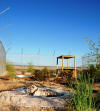 |
21. Double the fun with two tubs in one habitat. |